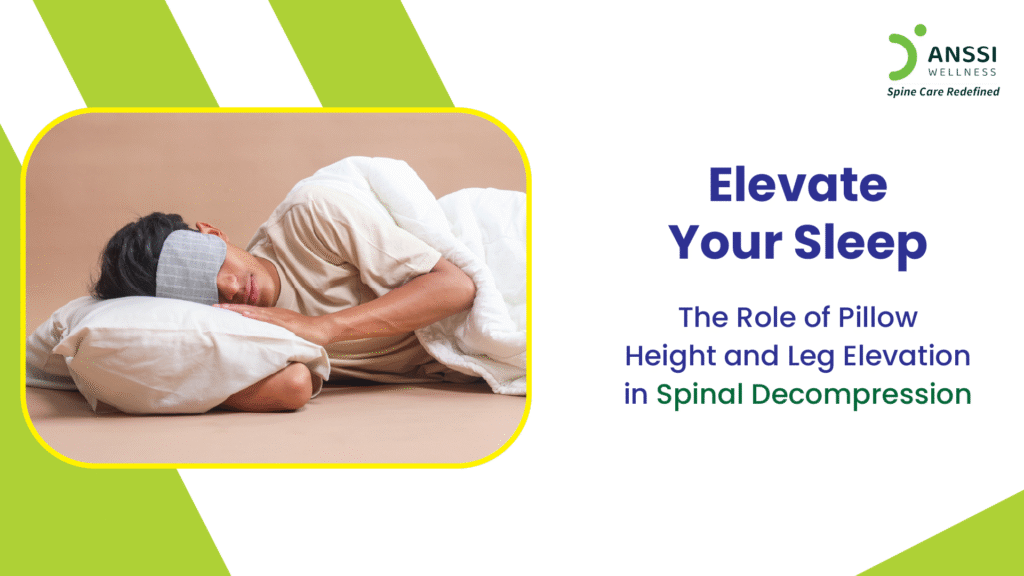Sleep is not just about resting the mind; it is also the body’s opportunity to repair, recover, and recharge. For the spine, sleep plays a vital role in reducing the stress and compression it endures during the day. The position you sleep in, along with the type of pillow and leg support you use, can significantly influence your spinal health.
Two often overlooked but critical factors are pillow height and leg elevation. Both directly affect spinal decompression, which is essential for preventing stiffness, pain, and long-term back or neck problems.
Understanding Spinal Compression During Sleep
Throughout the day, gravity constantly presses down on the spine. Hours of sitting, standing, and bending cause the intervertebral discs, the soft cushions between vertebrae, to lose hydration and shrink slightly.
At night, your spine gets a chance to recover and rehydrate, but poor sleep posture can interfere with this natural process. Sleeping with the wrong pillow height or without proper leg support can worsen spinal compression, leaving you waking up with neck stiffness, lower back pain, or general discomfort.
This makes supportive sleep posture one of the most important contributors to spinal health.
The Role of Pillow Height
Your pillow does more than just provide comfort; it ensures proper cervical spine alignment.
A pillow that is too high forces the neck forward or sideways, straining cervical discs and muscles. On the other hand, a pillow that is too low fails to support the natural curve of the neck, causing muscles to remain tense throughout the night. The ideal pillow maintains a neutral spine position, keeping the head, neck, and shoulders aligned.
- Memory foam and orthopedic pillows are particularly helpful because they adapt to the natural contours of the body.
- For side sleepers, a thicker pillow is needed to fill the gap between the shoulder and head.
- For back sleepers, a medium-height pillow that supports the neck without lifting the head too high is recommended.
- Choosing the right pillow height can reduce morning stiffness, improve sleep quality, and protect the cervical discs from unnecessary strain.
The Benefits of Leg Elevation
Just as pillow height protects the neck, leg elevation supports the lower back.
Lying flat with legs extended straight often places extra pressure on the lumbar discs, especially for individuals with back pain or sciatica. Elevating the legs slightly reduces this pressure by tilting the pelvis into a more natural alignment. This helps relax the muscles, improves circulation, and reduces compression on the lower spine.
- One simple technique is to place a pillow beneath the knees while sleeping on your back. This slight bend reduces lumbar stress significantly.
- For those with chronic lower back discomfort, wedge pillows designed specifically for leg elevation provide consistent support throughout the night.
- Even side sleepers can benefit by placing a pillow between their knees to keep the hips and spine aligned.
Practical Tips for Better Sleep Support
Test Your Pillow Height: Ensure your pillow supports the natural curve of your neck without tilting your head upward or downward.
- Invest in Adjustable Pillows: Memory foam or contour pillows offer customisable support that adapts to your sleep style.
- Elevate Your Legs Consistently: Use a wedge pillow or simple knee support for lumbar relief.
- Combine Support Strategies: Align your head with the right pillow height and support your lower back with leg elevation for complete spinal decompression.
- Experiment with Sleep Positions: While back sleeping is often recommended for spinal alignment, side sleeping with proper head and knee support can also reduce strain.
Non-Surgical Approach to Chronic Spinal Issues
Improving sleep posture is one of the most natural ways to aid spinal decompression, but in cases of chronic back or neck pain, additional support may be necessary.
- Non-surgical care options like physiotherapy, targeted stretching, and ice-heat therapy can help manage pain and restore mobility.
- One of the most advanced solutions is non-surgical spinal decompression treatment, which gently stretches the spine to relieve pressure on discs and nerves. When combined with proper pillow support and leg elevation at night, this treatment maximises disc hydration and healing, leading to long-term relief.
About ANSSI:
ANSSI Wellness focuses on improving the quality of life for patients suffering from spinal issues, aiming to provide relief where other conventional treatments have failed. Through advanced Non-Surgical Spinal Decompression Treatment, ANSSI is committed to helping patients avoid surgery and recover in a safe, effective, and compassionate environment.
Connect with ANSSI Wellness on LinkedIn, Instagram, and Facebook for expert guidance.




